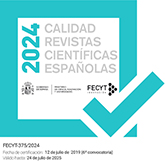Accent mark and visual word recognition in Spanish
DOI:
https://doi.org/10.3989/loquens.2015.018Keywords:
Spanish, accent mark, visual word recognition, lexical stress, lexical accessAbstract
The present research aims at determining to what extent an orthographic error related to the accent mark affects the visual recognition of Spanish words. For this, we conducted two experiments of visual lexical decision (with no word production), in which Spanish-speaking participants were instructed to ignore the presence or the absence of the accent mark. Stimuli were composed of words originally without accent mark (OrNA for ‘originally no accent’; Experiment 1) and words originally with an accent mark (OrWA for ‘originally with accent’; Experiments 1 and 2). OrNA words were presented in three conditions: correctly spelled (e.g., dulce ‘sweet’), with an added accent mark on the lexically stressed vowel ( dúlce) and with a misplaced accent mark on the lexically non-stressed vowel ( dulcé). Along the same line, OrWA words were also presented in three conditions: correctly spelled (e.g., lápiz ‘pen’), without the accent mark (lapiz) and with a misplaced accent mark (lapíz). Taken together, the results showed that the accent mark plays a role in the visual word recognition in Spanish. More specifically, the addition and/or the misplacement of an accent mark significantly slow down the visual recognition of the words, whereas the omission of the accent mark does not. The findings are discussed within the framework of dual-route models.
Downloads
References
Alameda, J. R., & Cuetos, F. (1995). Diccionario de frecuencias de las unidades lingü.sticas del castellano. Oviedo: Servicio de Publicaciones de la Universidad de Oviedo.
Ashby, J., & Clifton, C. (2005). The prosodic property of lexical stress affects eye movements during silent reading. Cognition, 96(3), B89–B100. http://dx.doi.org/10.1016/j.cognition.2004.12.006
Ayçiçegi, A., & Harris, C. L. (2002). How are letters containing diacritics represented? Repetition blindness for Turkish words. European Journal of Cognitive Psychology, 14(3), 371–382. http://dx.doi.org/10.1080/09541440143000113
Baayen, H. (2008). Analyzing linguistic data. A practical introduction to statistics using R. Cambridge, UK: Cambridge University Press. http://dx.doi.org/10.1017/CBO9780511801686
Baayen, R. H., Davidson, D. J., & Bates, D. M. (2008). Mixed-effects modeling with crossed random effects for subjects and items. Journal of Memory and Language, 59(4), 390–412. http://dx.doi.org/10.1016/j.jml.2007.12.005
Colombo, L. (1992). Lexical stress effect and its interaction with frequency in word pronunciation. Journal of Experimental Psychology: Human Perception and Performance, 18, 987–1003. http://dx.doi.org/10.1037/0096-1523.18.4.987
Colombo, L., Deguchi, C., & Boureux, M. (2014). Stress priming and statistical learning in Italian nonword reading: Evidence from children. Reading and Writing, 27, 923–943. http://dx.doi.org/10.1007/s11145-013-9476-x
Colombo, L., & Zevin, J. (2009). Stress priming in reading and the selective modulation of lexical and sub-lexical pathways. PLoS ONE, 4(9), e7219. http://dx.doi.org/10.1371/journal.pone.0007219
Coltheart, M., Rastle, K., Perry, C., Langdon, R., & Ziegler, J. (2001). DRC: A Dual Route Cascaded model of visual word recognition and reading aloud. Psychological Review, 108, 204–256. http://dx.doi.org/10.1037/0033-295X.108.1.204
Cubelli R., & Beschin, N. (2005). The processing of the right-sided accent mark in left neglect dyslexia. Brain and Language, 95(2), 319–326. http://dx.doi.org/10.1016/j.bandl.2005.02.002
Domínguez, A., & Cuetos, F. (2001). Lexical stress in visual word recognition: Contrastive value in Spanish. Unpublished manuscript, Departamento de Psicología Cognitiva, University of La Laguna.
Eisenstein, J. (2013). What to do about bad language on the internet. Proceedings of the Annual Conference of the North American Chapter of the Association for Computational Linguistics: Human Language Technologies (NAACL–HLT 2013), 359–369. http://www.aclweb.org/anthology/N13-1037
Ferrand, L. (2001). Cognition et Lecture. Processus de base de la reconnaissance des mots écrits chez l'adulte. Bruxelles: De Boeck Université.
Forster, J. C. (2015). DMDX updates page [Website]. Department of Psychology, University of Arizona. Retrieved from http:// www.u.arizona.edu/~jforster/dmdx.htm
Frost, R. & Katz, L. (1992). Orthography, phonology, morphology, and meaning. Amsterdam: Elsevier North Holland Press.
González-Nosti, M., Barbón, A., Rodríguez-Ferreiro, J., & Cuetos, F. (2014). Effects of the psycholinguistic variables on the lexical decision task in Spanish: A study with 2,765 words. Behavior Research Methods, 46(2), 517–525. http://dx.doi.org/10.3758/s13428-013-0383-5
Gross, J., Millett, A. L., Bartek, B., Bredell, K. H., & Winegard, B. (2013). Evidence for prosody in silent reading. Reading Research Quarterly, 49(2), 189–208. http://dx.doi.org/10.1002/rrq.67
Guasch, M., Boada, R., Ferré, P., & Sánchez-Casas, R. (2013). NIM: A Web-based Swiss army knife to select stimuli for psycholinguistic studies. Behavior Research Methods, 45, 765–771. http://dx.doi.org/10.3758/s13428-012-0296-8
Gutiérrez Palma, N., & Palma Reyes, A. (2004). Lexical stress and reading: A study with children. Electronic Journal of Research in Educational Psychology, 2(2), 143–160.
Gutiérrez Palma, N., & Palma Reyes, A. (2008). On the use of lexical stress in reading Spanish. Reading and Writing, 21, 645–660. http://dx.doi.org/10.1007/s11145-007-9082-x
Jara Murillo, C. V. (2013). COCAE: Corpus Cacográfico Adulto del Espa-ol de Costa Rica (Informe parcial 30/09/2013, Proyecto n.º 745-B2-A13). Universidad de Costa Rica. http://hdl.handle.net/10669/8928
Keeulers, E., & Brysbaert, M. (2010). Wuggy: A multilingual pseudoword generator. Behavior Research Methods, 42(3), 627–633. http://dx.doi.org/10.3758/BRM.42.3.627
Kuznetsova, A., Brockhoff, P. B., & Christensen, R. H. B. (2014). lmerTest: Tests in Linear Mixed Effects Models (v. 2.0-20) [Rpackage]. Retrieved from http://CRAN.R-project.org/package=lmerTest
Marian, V., Bartolotti, J., Chabal, S., & Shook, A. (2012). CLEARPOND: Cross-Linguistic Easy-Access Resource for Phonological and Orthographic Neighborhood Densities. PLoS ONE, 7(8), e43230. http://dx.doi.org/10.1371/journal.pone.0043230
Martín Plasencia, P., Iglesias Dorado J., & Serrano, J. M. (2008). Evidence for linguistic deficit in nonlexical processing in reading. A study of a Spanish-speaking patient. The Spanish Journal of Psychology, 11, 48–54. http://dx.doi.org/10.1017/S1138741600004108
Mathey, S., & Zagar, D. (2006). The orthographic neighbourhood frequency effect in French: A letter-case manipulation study. Canadian Journal of Experimental Psychology, 60(2), 159–165. http://dx.doi.org/10.1037/cjep2006015
Morton, J. (1969). Interaction of information in word recognition. Psychological Review, 76(2), 165–178. http://dx.doi.org/10.1037/h0027366
Pagliuca, G., & Monaghan, P. (2010). Discovering large grain-sizes in a transparent orthography: Insights from a connectionist model of Italian word naming. European Journal of Cognitive Psychology, 22, 813–835. http://dx.doi.org/10.1080/09541440903172158
Perea, M., Rosa, E., & Gómez, C. (2002). Is the go/no-go lexical decision task an alternative to the yes/no lexical decision task? Memory & Cognition, 30, 34–45.
Pérez, M. A., Alameda, J. R., & Cuetos Vega, F. (2003). Frecuencia, longitud y vecindad ortográfica de las palabras de 3 a 16 letras del Diccionario de la Lengua Espa-ola (RAE, 1992). Revista Electrónica de Metodología Aplicada, 8(2), 1–10.
Perry, C., Ziegler, J. C., & Zorzi, M. (2010). Beyond single syllables: Large-scale modeling of reading aloud with the Connectionist Dual Process (CDP++) model. Cognitive Psychology, 61(2), 106–151. http://dx.doi.org/10.1016/j.cogpsych.2010.04.001
Perry, C., Ziegler, J. C., & Zorzi, M. (2014). CDP++. Italian: Modelling sublexical and supralexical inconsistency in a shallow orthography. Plos One, 9(4), e94291.
Protopapas, A. (in press). From diacritics to the mental lexicon: Where is the stress? In J. Thomson & L. Jarmulowicz (Eds.), Linguistic rhythm and literacy. John Benjamins. Retrieved from http://users.uoa.gr/~aprotopapas/CV/pdf/Protopapas_Ti-LARch14_draft2.pdf
Protopapas, A., & Gerakaki, S. (2009). Development of processing stress diacritics in reading Greek. Scientific Studies of Reading, 13, 453–483. http://dx.doi.org/10.1080/10888430903034788
Protopapas, A., Gerakaki, S., & Stella, A. (2007). Sources of information for stress assignment in reading Greek. Applied Psycholinguistics, 28, 695–720. http://dx.doi.org/10.1017/S0142716407070373
Pujol, M. (2005). La ortografía. In S. Torner & P. Battaner (Eds.), El corpus PAAU 1992: Estudios descriptivos, textos y vocabulario (pp. 29–65). Barcelona: Universitat Pompeu Fabra.
Quilis, A. (1981). Fonética acústica de la lengua espa-ola. Madrid: Gredos.
Quilis, A. (1993). Tratado de fonología y fonética espa-olas. Madrid: Gredos.
Rastle, K., & Coltheart, M. (2000). Lexical and nonlexical print-tosound translation of disyllabic words and nonwords. Journal of Memory and Language, 42, 342–364. http://dx.doi.org/10.1006/jmla.1999.2687
Real Academia Espa-ola y Asociación de Academias de la Lengua Espa-ola (2005). Diccionario panhispánico de dudas. Madrid: Santillana.
Seidenberg, M. S., & McClelland, J. L. (1989). A distributed, developmental model of word recognition and naming. Psychological Review, 96(4), 523–568. http://dx.doi.org/10.1037/0033-295X.96.4.523
Seva, N., Monaghan, P., & Arciuli, J. (2009). Stressing what is important: Orthographic cues and lexical stress assignment. Journal of Neurolinguistics, 22, 237–249. http://dx.doi.org/10.1016/j.jneuroling.2008.09.002
Soto-Faraco, S., Sebastián-Gallés, N., & Cutler, A. (2001). Segmental and suprasegmental mismatch in lexical access. Journal of Memory and Language, 45, 412–432. http://dx.doi.org/10.1006/jmla.2000.2783
The English Spelling Society (2010). The changing face of spelling on the internet. A research document drawn from research at Manchester University. Research notes and diagrams courtesy of Lucy Jones. http://pdf.thepdfportal.net/PDFFiles/129174.pdf
van Orden, G. C. (1987). A ROWS is a ROSE: Spelling, sound, and reading. Memory & Cognition, 15, 181–198. http://dx.doi.org/10.3758/BF03197716
Zagar, D., & Mathey, S. (2000). When words with higher-frequency neighbours become words with no higher-frequency neighbours (or how to undress the neighbourhood frequency effect). In A. Kennedy, R. Radach, D. Heller, & J. Pynte (Eds.), Reading as a perceptual process (pp. 23–46). Oxford: Elsevier.
Ziegler, J. C., Perry, C., & Coltheart, M. (2000). The DRC model of visual word recognition and reading aloud: An extension to German. European Journal of Cognitive Psychology, 12, 413–430. http://dx.doi.org/10.1080/09541440050114570
Published
How to Cite
Issue
Section
License
Copyright (c) 2015 Consejo Superior de Investigaciones Científicas (CSIC)

This work is licensed under a Creative Commons Attribution 4.0 International License.
© CSIC. Manuscripts published in both the print and online versions of this journal are the property of the Consejo Superior de Investigaciones Científicas, and quoting this source is a requirement for any partial or full reproduction.
All contents of this electronic edition, except where otherwise noted, are distributed under a Creative Commons Attribution 4.0 International (CC BY 4.0) licence. You may read the basic information and the legal text of the licence. The indication of the CC BY 4.0 licence must be expressly stated in this way when necessary.
Self-archiving in repositories, personal webpages or similar, of any version other than the final version of the work produced by the publisher, is not allowed.














